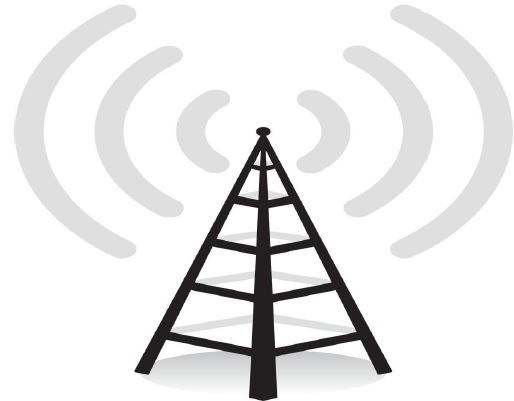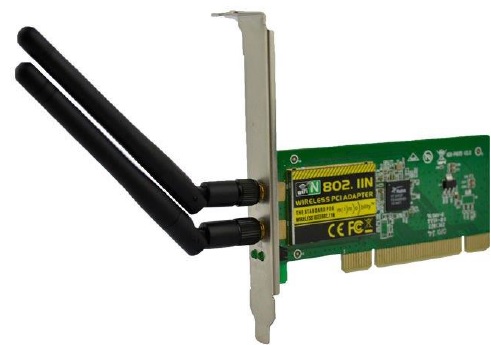Wi-Fi是什么 ?
WiFi代表Wireless Fidelity 。WiFi它基于IEEE 802.11系列标准,主要是为了提供室内宽带覆盖而设计的局域网(LAN)技术。
当前的WiFi系统支持54Mbps的峰值物理层数据速率,并且通常在100英尺的距离内提供室内覆盖。
WiFi已成为家庭,办公室和公共热点地区最后一公里宽带连接的事实标准。 系统通常可以提供离接入点仅约1000英尺的覆盖范围。

与3G系统相比,WiFi提供的峰值数据速率显着更高,主要是因为它运行在更大的20 MHz带宽上,但WiFi系统并不支持高速移动性。
WiFi在WiMAX和3G上的一个显着优势是终端设备的广泛可用性。 目前出货的绝大多数笔记本电脑都有内置的WiFi接口。 WiFi接口现在也在内置于各种设备中,包括个人数据助理(PDA),无绳电话,手机,相机和媒体播放器。
WiFi 是半双工的(Half Duplex)
所有的WiFi网络都是基于竞争的TDD系统,其中接入点(AP)和移动台(Station)都争用相同的信道。 由于共享媒体操作,所有的WiFi网络都是半双工的。
有设备供应商销售WiFi网状配置,但是这些实现包含了标准中没有定义的技术。
信道带宽
WiFi标准为802.11b和g网络定义了一个固定的信道带宽,即802.11b 25MHz,802.11g或者802.11a20MHz。
Wi-Fi – 工作组件
无线电信号(Radio Signals)
Radio Signals are the keys, which make WiFi networking possible. These radio signals transmitted from WiFi antennas are picked up by WiFi receivers, such as computers and cell phones that are equipped with WiFi cards. Whenever, a computer receives any of the signals within the range of a WiFi network, which is usually 300 — 500 feet for antennas, the WiFi card reads the signals and thus creates an internet connection between the user and the network without the use of a cord.

Access points, consisting of antennas and routers, are the main source that transmit and receive radio waves. Antennas work stronger and have a longer radio transmission with a radius of 300-500 feet, which are used in public areas while the weaker yet effective router is more suitable for homes with a radio transmission of 100-150 feet.
WiFi网卡(WiFi Cards)
You can think of WiFi cards as being invisible cords that connect your computer to the antenna for a direct connection to the internet.

WiFi cards can be external or internal. If a WiFi card is not installed in your computer, then you may purchase a USB antenna attachment and have it externally connect to your USB port, or have an antenna-equipped expansion card installed directly to the computer (as shown in the figure given above). For laptops, this card will be a PCMCIA card which you insert to the PCMCIA slot on the laptop.
WiFi 热点(Hotspots)
A WiFi hotspot is created by installing an access point to an internet connection. The access point transmits a wireless signal over a short distance. It typically covers around 300 feet. When a WiFi enabled device such as a Pocket PC encounters a hotspot, the device can then connect to that network wirelessly.
通过安装访问点到互联网连接创建WiFi热点。 接入点传输短距离的无线信号。 它通常覆盖约300英尺。 当支持WiFi的设备(如Pocket PC)遇到热点时,设备可以无线连接到该网络。
Most hotspots are located in places that are readily accessible to the public such as airports, coffee shops, hotels, book stores, and campus environments. 802.11b is the most common specification for hotspots worldwide. The 802.11g standard is backwards compatible with .11b but .11a uses a different frequency range and requires separate hardware such as an a, a/g, or a/b/g adapter. The largest public WiFi networks are provided by private internet service providers (ISPs); they charge a fee to the users who want to access the internet.
大多数热点位于机场,咖啡店,酒店,书店和校园环境等公共场所。 802.11b是全球热点最常用的规范。 802.11g标准向后兼容.11b,但.11a使用不同的频率范围,需要单独的硬件,如a,a / g或a / b / g适配器。 最大的公共WiFi网络由私人互联网服务提供商(ISP)提供; 他们向想要访问互联网的用户收取费用。

Hotspots are increasingly developing around the world. In fact, T-Mobile USA controls more than 4,100 hotspots located in public locations such as Starbucks, Borders, Kinko’s, and the airline clubs of Delta, United, and US Airways. Even select McDonald’s restaurants now feature WiFi hotspot access.
世界各地的热点日益发展。 事实上,T-Mobile USA控制着位于星巴克,边界,金考等公共场所的超过4100个热点,还有Delta,United和US Airways的航空公司。 即使选择麦当劳餐厅现在功能WiFi热点访问。
Any notebook computer with integrated wireless, a wireless adapter attached to the motherboard by the manufacturer, or a wireless adapter such as a PCMCIA card can access a wireless network. Furthermore, all Pocket PCs or Palm units with Compact Flash, SD I/O support, or built-in WiFi, can access hotspots.
任何具有集成无线的笔记本电脑,制造商连接到主板的无线适配器或无线适配器(如PCMCIA卡)都可以访问无线网络。 此外,所有具有Compact Flash,SD I / O支持或内置WiFi的Pocket PC或Palm设备都可以访问热点。
Some Hotspots require WEP key to connect, which is considered as private and secure. As for open connections, anyone with a WiFi card can have access to that hotspot. So in order to have internet access under WEP, the user must input the WEP key code.
某些热点需要WEP密钥进行连接,这被认为是私密和安全的。 至于开放连接,任何拥有WiFi卡的人都可以访问该热点。 因此,为了在WEP下访问互联网,用户必须输入WEP密钥。
Wi-Fi – IEEE 标准
The 802.11 standard is defined through several specifications of WLANs. It defines an over-the-air interface between a wireless client and a base station or between two wireless clients.
There are several specifications in the 802.11 family −
- 802.11 − This pertains to wireless LANs and provides 1 – or 2-Mbps transmission in the 2.4-GHz band using either frequency-hopping spread spectrum (FHSS) or direct-sequence spread spectrum (DSSS).
- 802.11a − This is an extension to 802.11 that pertains to wireless LANs and goes as fast as 54 Mbps in the 5-GHz band. 802.11a employs the orthogonal frequency division multiplexing (OFDM) encoding scheme as opposed to either FHSS or DSSS.
- 802.11b − The 802.11 high rate WiFi is an extension to 802.11 that pertains to wireless LANs and yields a connection as fast as 11 Mbps transmission (with a fallback to 5.5, 2, and 1 Mbps depending on strength of signal) in the 2.4-GHz band. The 802.11b specification uses only DSSS. Note that 802.11b was actually an amendment to the original 802.11 standard added in 1999 to permit wireless functionality to be analogous to hard-wired Ethernet connections.
- 802.11g − This pertains to wireless LANs and provides 20+ Mbps in the 2.4-GHz band.
Here is the technical comparison between the three major WiFi standards.
| Feature | WiFi (802.11b) | WiFi (802.11a/g) |
|---|---|---|
| PrimaryApplication | Wireless LAN | Wireless LAN |
| Frequency Band | 2.4 GHz ISM | 2.4 GHz ISM (g)
5 GHz U-NII (a) |
| Channel Bandwidth | 25 MHz | 20 MHz |
| Half/Full Duplex | Half | Half |
| Radio Technology | Direct Sequence
Spread Spectrum |
OFDM
(64-channels) |
| Bandwidth | <=0.44 bps/Hz | ≤=2.7 bps/Hz |
| Efficiency | ||
| Modulation | QPSK | BPSK, QPSK, 16-, 64-QAM |
| FEC | None | Convolutional Code |
| Encryption | Optional- RC4m (AES in 802.11i) | Optional- RC4(AES in 802.11i) |
| Mobility | In development | In development |
| Mesh | Vendor Proprietary | Vendor Proprietary |
| Access Protocol | CSMA/CA | CSMA/CA |
Wi-Fi – 访问协议(Access Protocols)
IEEE 802.11 wireless LANs use a media access control protocol called Carrier Sense Multiple Access with Collision Avoidance (CSMA/CA). While the name is similar to Ethernet’s Carrier Sense Multiple Access with Collision Detection (CSMA/CD), the operating concept is totally different.
IEEE 802.11无线局域网使用称为载波侦听多路访问和冲突避免(CSMA / CA)的媒体访问控制协议。 虽然名称与以太网的载波侦听多路访问碰撞检测(CSMA / CD)类似,但操作原理完全不同。
WiFi systems are the half duplex shared media configurations, where all stations transmit and receive on the same radio channel. The fundamental problem of a radio system is that a station cannot hear while it is sending, and hence it is impossible to detect a collision. Because of this, the developers of the 802.11 specifications came up with a collision avoidance mechanism called the Distributed Control Function (DCF).
WiFi系统是半双工共享媒体配置,其中所有站点在相同的无线电信道上发送和接收。 无线电系统的根本问题是,一个电台在发送时听不到,因此不可能检测到一个冲突。 正因为如此,802.11规范的开发者提出了一种称为分布式控制功能(DCF)的冲突避免机制。
According to DCF, a WiFi station will transmit only when the channel is clear. All transmissions are acknowledged, so if a station does not receive an acknowledgement, it assumes a collision occurred and retries after a random waiting interval.
根据DCF,只有当频道清空时,WiFi站才会发送。 所有传输都被确认,所以如果一个站点没有收到确认,它就会假设发生了一个冲突,并且在一个随机的等待间隔之后重试。
The incidence of collisions will increase as the traffic increases or in situations where mobile stations cannot hear each other.
碰撞发生率将随着流量增加或移动台不能相互听到的情况而增加。
Wi-Fi – 服务质量(Quality of Service ——QoS)
There are plans to incorporate quality of service (QoS) capabilities in WiFi technology with the adoption of the IEEE 802.11e standard. The 802.11e standard will include two operating modes, either of which can be used to improve service for voice −
有计划将采用IEEE 802.11e标准的WiFi技术的服务质量(QoS)能力纳入其中。 802.11e标准将包括两种操作模式,其中任何一种都可以用来改善语音服务——
- WiFi Multimedia Extensions (WME) − Mandatory
- WiFi Scheduled Multimedia (WSM) − Optional
WiFi多媒体扩展(WiFi Multimedia Extensions——WME)
WiFi Multimedia Extensions use a protocol called Enhanced Multimedia Distributed Control Access (EDCA), which is an extension of an enhanced version of the Distributed Control Function (DCF) defined in the original 802.11 MAC.
WiFi多媒体扩展使用称为增强多媒体分布式控制接入(EDCA)的协议,该协议是在原始802.11 MAC中定义的分布式控制功能(DCF)的增强版本的扩展。
The enhanced part is that EDCA will define eight levels of access priority to the shared wireless channel. Like the original DCF, the EDCA access is a contention-based protocol that employs a set of waiting intervals and back-off timers designed to avoid collisions. However, with DCF all stations use the same values and hence have the same priority for transmitting on the channel.
增强的部分是EDCA将为共享无线信道定义八个级别的接入优先级。 与最初的DCF一样,EDCA访问是基于竞争的协议,采用一组等待间隔和退避计时器来避免冲突。 但是,对于DCF,所有电台使用相同的值,因此在信道上传输具有相同的优先级。
With EDCA, each of the different access priorities is assigned a different range of waiting intervals and back-off counters. Transmissions with higher access priority are assigned shorter intervals. The standard also includes a packet-bursting mode that allows an access point or a mobile station to reserve the channel and send 3- to 5-packets in a sequence.
通过EDCA,每个不同的访问优先级被分配一个不同的等待间隔和退避计数器的范围。 较高访问优先级的传输被分配较短的时间间隔。 该标准还包括一个数据包爆发模式,允许接入点或移动台预留信道,并按顺序发送3到5个数据包。
WiFi预定(Scheduled)多媒体(WSM)
True consistent delay services can be provided with the optional WiFi Scheduled Multimedia (WSM). WSM operates like the little used Point Control Function (PCF) defined with the original 802.11 MAC.
真正一致的延迟服务可以通过可选的WiFi预定多媒体(WSM)提供。 WSM的操作就像使用原始802.11 MAC定义的小点控制功能(PCF)一样。
In WSM, the access point periodically broadcasts a control message that forces all stations to treat the channel as busy and not attempt to transmit. During that period, the access point polls each station that is defined for time sensitive service.
在WSM中,接入点周期性地广播一个控制消息,强制所有的站点把这个信道看作是忙的,而不是试图传输。 在此期间,接入点轮询为时间敏感服务定义的每个站点。
To use the WSM option, devices need to send a traffic profile describing bandwidth, latency, and jitter requirements. If the access point does not have sufficient resources to meet the traffic profile, it will return a busy signal.
要使用WSM选项,设备需要发送描述带宽,延迟和抖动要求的流量配置文件。 如果接入点没有足够的资源来满足流量模式,它将返回一个忙音信号。
Wi-Fi – 安全(Security)
Security has been one of the major deficiencies in WiFi, though better encryption systems are now becoming available. Encryption is optional in WiFi, and three different techniques have been defined. These techniques are given here −
有线等效保密(Wired Equivalent Privacy ——WEP)
An RC4-based 40-or 104-bit encryption with a static key.
WiFi保护访问(WiFi Protected Access ——WPA)
This is a new standard from the WiFi Alliance that uses the 40 or 104-bit WEP key, but it changes the key on each packet. That changing key functionality is called the Temporal Key Integrity Protocol (TKIP).
IEEE 802.11i/WPA2
The IEEE is finalized the 802.11i standard, which is based on a far more robust encryption technique called the Advanced Encryption Standard. The WiFi Alliance designate products that comply with the 802.11i standard as WPA2.
However, implementing 802.11i requires a hardware upgrade.
Wi-Fi – 网络服务(Network Services)
由于提供商开始使用WiFi来提供最初设计时并没有涉及的服务,因此这种情况已经变得有些困惑。 这两个主要的例子是无线ISP和城市范围的WiFi网状网络。
Wireless ISPs (WISPs)
无线ISP(WISP)是一个由WiFi产生的业务。 这是一个使用无线局域网技术和在指定为热点的公共场所共享互联网连接的互联网接入服务的想法。
从技术角度来看,基于WLAN技术的传输范围,对服务的访问是有限的。 您必须处于热点(即接入点100米范围内)才能使用它。 从商业的角度来看,用户要么订阅特定的运营商的服务,要么收取月费,要么以每小时收费的方式访问服务。 虽然每月费用基础是最具成本效益的,但运营商之间的接入安排很少,所以你必须在你的运营商的热点,以访问您的服务。
全城网状网络(City-Wide Mesh Networks)
To address the limited range, vendors like Mesh Networks and Tropos Networks have developed mesh network capabilities using WiFi’s radio technology.
The idea of a radio mesh network is that messages can be relayed through a number of access points to a central network control station. These networks can typically support mobility as connections are handed off from access point to access point as the mobile station moves.
Some municipalities are using WiFi mesh networks to support public safety applications (i.e. terminals in police cruisers) and to provide Internet access to the community (i.e. the city-wide hot spot).
为了解决有限的范围,像Mesh Networks和Tropos Networks这样的供应商使用WiFi的无线电技术开发了网状网络功能。
无线网状网络的思想是可以通过多个接入点将消息中继到中央网络控制站。 这些网络通常可以支持移动性,因为当移动台移动时,连接从接入点切换到接入点。
一些市政当局正在使用WiFi网状网络来支持公共安全应用(即警察巡洋舰的终端),并为社区(即全市热点)提供互联网接入。
Wi-Fi – 无线电调制(Radio Modulation)
WiFi系统使用两种主要的无线电传输技术。
- 802.11b (<=11 Mbps) − The 802.11b radio link uses a direct sequence spread spectrum technique called complementary coded keying (CCK). The bit stream is processed with a special coding and then modulated using Quadrature Phase Shift Keying (QPSK).
802.11b无线电链路使用称为互补编码键控(CCK)的直接序列扩频技术。 比特流用特殊编码处理,然后用正交相移键控(QPSK)进行调制。
- 802.11a and g (<=54 Mbps) − The 802.11a and g systems use 64-channel orthogonal frequency division multiplexing (OFDM). In an OFDM modulation system, the available radio band is divided into a number of sub-channels and some of the bits are sent on each. The transmitter encodes the bit streams on the 64 subcarriers using Binary Phase Shift Keying (BPSK), Quadrature Phase Shift Keying (QPSK), or one of two levels of Quadrature Amplitude Modulation (16, or 64-QAM). Some of the transmitted information is redundant, so the receiver does not have to receive all of the sub-carriers to reconstruct the information.
802.11a和g系统使用64通道正交频分复用(OFDM)。 在OFDM调制系统中,可用的无线电频带被分成多个子信道,并且一些比特被发送。 发射机使用二进制相移键控(BPSK),正交相移键控(QPSK)或两个正交幅度调制(16或64-QAM)级别之一对64个子载波上的比特流进行编码。 一些传输的信息是冗余的,所以接收机不必接收所有的子载波来重建信息。
The original 802.11 specifications also included an option for frequencyhopping spread spectrum (FHSS), but that has largely been abandoned.
最初的802.11规范还包括频率跳频扩频(FHSS)的选项,但基本上已被放弃。
自适应调制(Adaptive Modulation)
WiFi uses adaptive modulation and varying levels of forward error correction to optimize transmission rate and error performance.
WiFi使用自适应调制和不同级别的前向纠错来优化传输速率和错误性能。
As a radio signal loses power or encounters interference, the error rate will increase. Adaptive modulation means that the transmitter will automatically shift to a more robust, though less efficient, modulation technique in those adverse conditions.
当无线电信号掉电或遇到干扰时,错误率会增加。 自适应调制意味着在这些不利条件下,发射机将自动转换为更稳健但效率更低的调制技术。
Wi-Fi – 主要问题(Major Issues)
There are a few issues that are assumed to be the cause behind the sluggish adoption of WiFi technology −
有一些问题被认为是WiFi技术缓慢采用的原因
- Security Problems − Security concerns have held back WiFi adoption in the corporate world. Hackers and security consultants have demonstrated how easy it can be to crack the current security technology known as wired equivalent privacy (WEP) used in most WiFi connections. A hacker can break into a WiFi network using readily available materials and software.
- 安全问题妨碍了企业界采用WiFi。 黑客和安全顾问已经证明,破解大多数WiFi连接中使用的被称为有线等效隐私(WEP)的当前安全技术是多么容易。 黑客可以利用现成的材料和软件打入WiFi网络。
- Compatibility and Interoperability − One of the major problems with WiFi is its compatibility and interoperability. For example, 802.11a products are not compatible with 802.11b products. Due to different operating frequencies, 802.11a hotspots would not help an 802.11b client. Due to lack of standardization, harmonization, and certification, different vendors come out with products that do not work with each other.
- WiFi的一个主要问题是兼容性和互操作性。 例如,802.11a产品与802.11b产品不兼容。 由于不同的工作频率,802.11a热点无助于802.11b客户端。 由于缺乏标准化,协调和认证,不同的厂商出现了不相互配合的产品。
- Billing Issues − WiFi vendors are also looking for ways to solve the problem of back-end integration and billing, which have dogged the roll-out of commercial WiFi hotspots. Some of the ideas under consideration for WiFi billing such as per day, per hour, and unlimited monthly connection fees.
- WiFi厂商也在寻求解决后端集成和计费问题的方法,这些方案阻碍了商业WiFi热点的推出。 一些正在考虑WiFi计费的想法,如每天,每小时,无限的每月连接费。
Wi-Fi – 概要
WiFi is a universal wireless networking technology that utilizes radio frequencies to transfer data. WiFi allows high-speed Internet connections without the use of cables.
The term WiFi is a contraction of “wireless fidelity” and commonly used to refer to wireless networking technology. The WiFi Alliance claims rights in its uses as a certification mark for equipment certified to 802.11x standards.
WiFi is a freedom – freedom from wires. It allows you to connect to the Internet from just about anywhere — a coffee shop, a hotel room, or a conference room at work. What’s more – it is almost 10 times faster than a regular dial-up connection. WiFi networks operate in the unlicensed 2.4 radio bands, with an 11 Mbps (802.11b) or 54 Mbps (802.11a) data rate, respectively.
To access WiFi, you need WiFi enabled devices (laptops or PDAs). These devices can send and receive data wirelessly in any location equipped with WiFi access.
下一步是什么?
Now, the focus in wireless is shifting to wide area, i.e., WiMax. WiMax, short for Worldwide Interoperability for Microwave Access, is defined in IEEE 802.16 standards. It is designed to deliver a metro area broadband wireless access (BWA) service, and is being promoted by the WiMax Forum.
WiMAX is quite similar to WiFi, but on a much larger scale and at faster speeds. A nomadic version would keep WiMAX-enabled devices connected over a large area, much like today’s cell phones.
For more detail on WiMAX, you can go through our WiMAX Tutorial.
This file is from :http://www.tutorialspoint.com/wi-fi/wifi_quick_guide.htm
